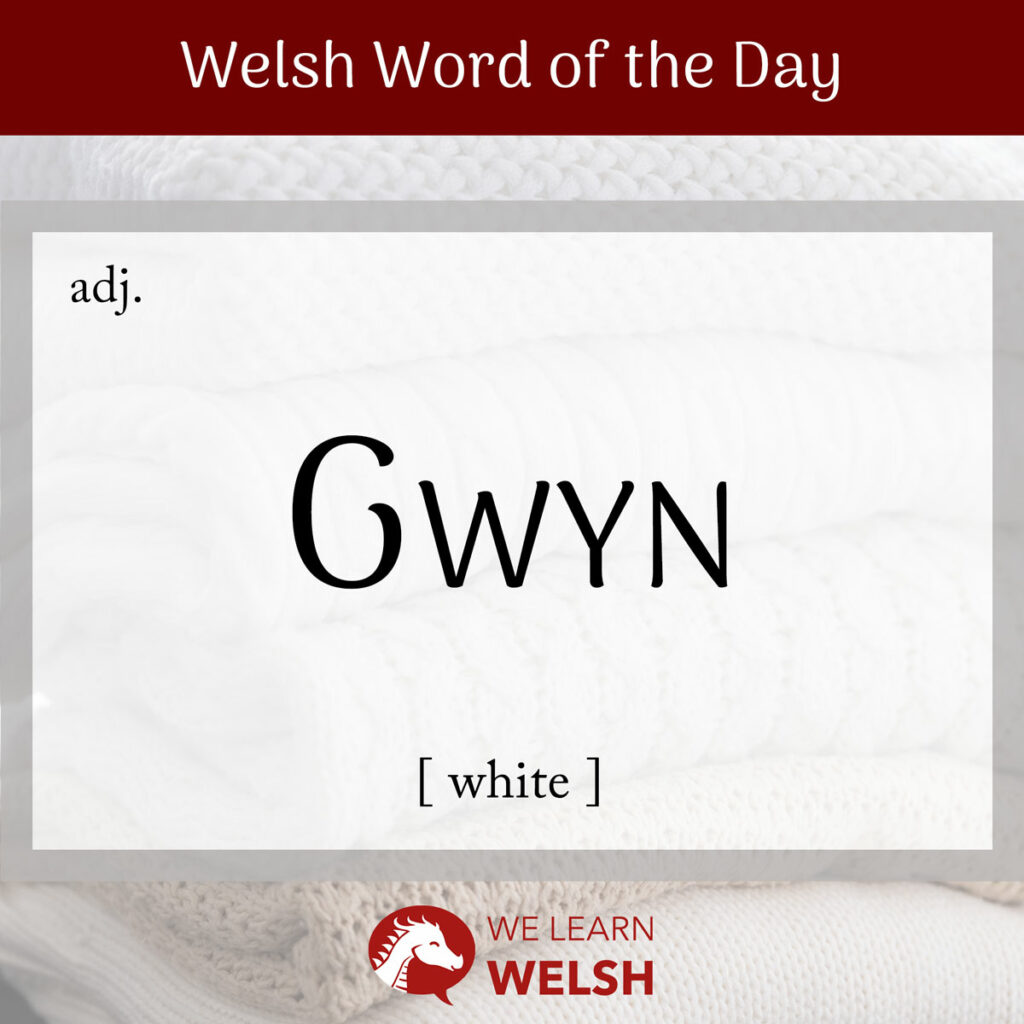The word gwyn (white) crops up a lot in Welsh poetry, proverbs, and folklore. This is because, as well as being the simple word for a common lliw (colour), it carries religious and mythical undertones relating to blessings and sacredness.
gwyn
white
Its etymology, on the other hand, is fairly mundane. It comes directly from a proto-Celtic root, probably something along the lines of *windos. Interestingly, this makes it a cognate of the Irish Fionn, which is also prominent in mythology as the name of the legendary hero Fionn mac Cumhaill.
Gwyn mutates like this:
Soft mutation
wyn
Nasal mutation
ngwyn
Aspirate mutation
N/A
But mutations aren’t the only way it changes. Most adjectives in Welsh have plural versions, but they’re often not used in everyday speech. However, an exception is generally made for colours, where the complex grammatical rules surrounding number and gender are more likely to be respected.
So, it’s worth knowing that the plural form of gwyn is gwynion, and the feminine singular is gwen.
If you’re sharp on your mutation rules, you’ll know that gwen will almost always appear as wen. This is because feminine nouns cause a soft mutation to the adjective that follows them. While a white dog is a ci gwyn, a white cat is a cath wen. And of course, a white goat is a gafr wen!
However, we still don’t say that wen is the feminine form of gwyn. It just so happens that it appears that way most of the time.
There are a few useful basic words that are derived from gwyn. For example, gwynnu means to whiten, as in mae ei wallt yn gwynnu (his hair is whitening), and gwynder is whiteness. Another good one is llwydwyn, grey-white, used to refer to what we call off-white in English.
While whiter is gwynnach and whitest is gwynnaf, Welsh also has another comparative form of adjectives. This is called the equative, and in this case, it’s gwynned. Gwynned sort of means as white as, but you couldn’t just say, for example, gwynned eira to mean as white as snow. You’d have to use it in the phrase cyn wynned ag eira. Here, cyn has caused a soft mutation.
Mae gen i ddwy gath wen ac un gath ddu.
I have two white cats and one black cat.
Gwyn has often been used more generally to refer to objects that aren’t just white but silver and shining. For example, arian gwynion is silver money.
In an even more abstract sense, gwyn refers to something blessed. The most famous expression that uses gwyn in this way is gwyn ei fyd (his world is blessed). This is a poetic way to say that someone is very lucky; essentially, they live a charmed life. But it also turns up in exclamations like Nefoedd wen! / Nefi wen! (Blessed heavens!) or Duw gwyn! (Good Lord!)
Interestingly, medieval Welsh writers sometimes describe the island of Britain as yr ynys wen (the blessed island). It’s a nicer, more grateful take on this rainy little isle we’re all so used to complaining about.
This is just the tip of the rhewfryn (iceberg) of all the common Welsh expressions that are based around gwyn, and many of them don’t fit easily into one of the meanings it’s known to have. This reflects just how vague and expansive the meaning and symbolism of this word is in Welsh!
- bore gwyn = early morning
- trwy wyn y dydd = all day long
- cynffon wen = the art of flattery (literally: a white tail)
- cythraul gwyn = an argument in church (literally: a white devil)
- lleuad wen = a bright or silvery moon
- celwydd gwyn = a white lie
- mam wen, tad gwyn (etc) = step-mother, step-father (etc)
- mae afu wen ganddo = he is a serial widower (literally: he has a white liver)
I also think it’s quite surprising that, given the positive associations of gwyn in the Welsh language (and to some extent, folklore), the most famous incident of the colour in Welsh mythology is that of y Ddraig Wen (the White Dragon) of the country’s oldest rival, Lloegr (England).
The Mabinogion, Wales’ most iconic collection of mythology, tells the story of two dreigiau (dragons), one coch (red) and one gwyn. King Llud traps the two dragons under the ground at Dinas Emrys, where they are engaged in a centuries-long battle.
But the Welsh believe that y Ddraig Goch (the red dragon) will eventually be victorious, symbolising Cymru (Wales) breaking free from English domination.
Efallai y prynaf i esgidiau newydd gwyn.
Maybe I will buy some new white shoes.
The word also appears in many wise Welsh proverbs. The most well-known of these is probably gwyn y gwêl y frân ei chyw, which means the crow sees its chick as white. It’s most often used to convey the idea that a parent can’t see their own children’s faults, but can also express the sentiment of beauty being in the eye of the beholder.
However, the more hardd (beautiful) and da (good) someone appears, the more striking their faults are, as amlwg llaid ar farch gwyn (mud is obvious on a white steed). So be careful about being ar gefn dy geffyl gwyn (on your white horse / on your high horse)!
No matter where you’ve gone wrong, you can always get a fresh start by throwing your hands up and saying gwyn pob newydd, llwyd pob hen (everything new is white, everything old is grey). After all, man gwyn man draw (over there is a white place / the grass is greener on the other side).
Gwyn, Wyn, and Gwen are all very common first names in Wales, both stand-alone and exist as components of longer names. Often the same name will have a masculine and feminine form, ending -wyn for men and -wen for women – like the duo Eirwyn and Eirwen, which mean white snow. In fact, we even have a Gwen writing for this very blog!


